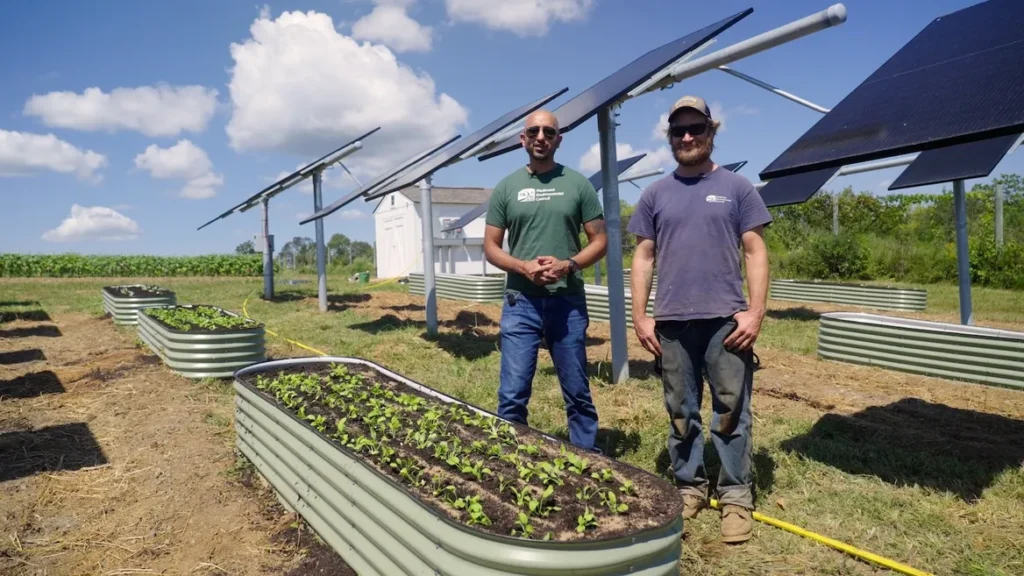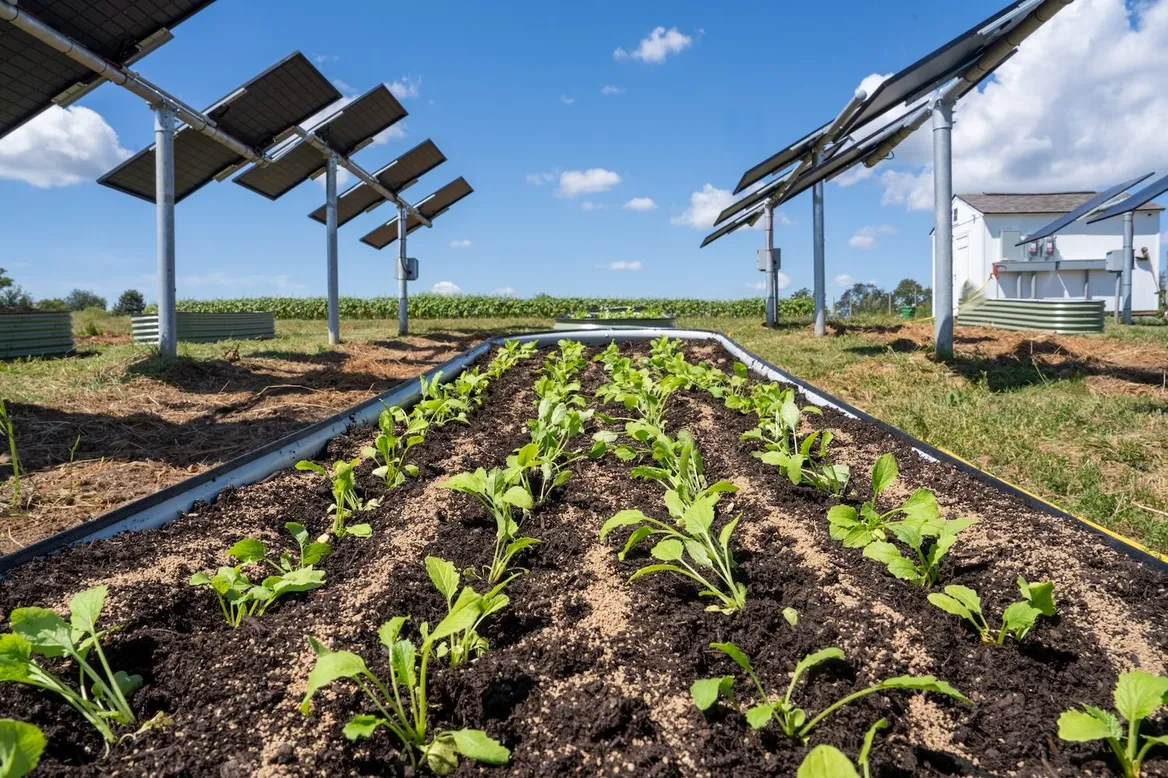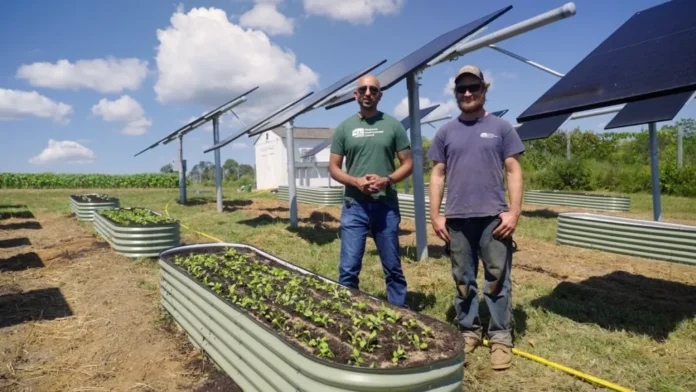
The Piedmont Environmental Council’s Ashish Kapoor, left, and Teddy Pitsiokos stand near raised beds at the nonprofit’s agrivoltaics demo site. (Photo by Hugh Kenny/Piedmont Environmental Council)
By Elizabeth Ouzts/Canary Media
More than a decade ago, residents of Loudoun County, Virginia, banded together to buy up treasured open space before it became a strip mall and housing development, donating the land to the Piedmont Environmental Council instead. The nonprofit has maintained it as a unique blend of cattle pasture, a nature preserve, and a community farm that donates its yield to a local food pantry.
Now, a small corner of the farm has become what organizers say is a first for the state: a crop-based agrivoltaics demonstration project. They hope the combination of solar panels and vegetable farming will showcase how much-needed renewable energy can complement, not harm, agricultural lands, at a time when data centers are demanding more and more electricity.
The Virginia Clean Economy Act requires the state’s largest utility, Dominion Energy, to stop burning fossil fuels by 2045 and to develop 16,100 megawatts of land-based renewable energy by 2035 — mostly in the form of solar.
Virginia has more than enough room to meet that target without threatening great swaths of farmland. Using a conservative metric that 10 acres of land can host 1 megawatt of solar capacity, a Nature Conservancy analysis found that the state has 40 times more suitable land area than needed for solar fields, even after ruling out over 2 million acres of “prime conservation lands” including farmland.
Researchers from Virginia Commonwealth University determined that large-scale solar today is erected on less than 1% of the state’s cropland. Under a “high-growth scenario,” that figure could rise to 3.1% by 2035, including 1.2% of the state’s federally designated prime farmland. Yet low-density residential development may pose a far greater threat to those spaces, according to research by the nonprofit American Farmland Trust, which advocates for “smart solar” that doesn’t jeopardize agricultural land.
In fact, many landowners find that renting a portion of their land to solar companies can help their farming enterprise pencil out financially, reducing pressure to sell their property to developers. An acre of land, after all, may yield hundreds of dollars if devoted to crops but thousands if leased for panels.
And yet there’s no doubt that solar has grown exponentially in the state in the last decade, and that it has disproportionately displaced farmland. Cropland makes up 5% of Virginia’s total acreage but 28% of the land area now used for large-scale solar, the Virginia Commonwealth University researchers found.
Especially in the early years of renewable-energy construction, some companies set a poor example for responsible development, said Ashish Kapoor, senior energy and climate advisor with the Piedmont Environmental Council. “It was a little bit ‘Wild West,’” he said. “Those early projects in 2018, 2019 — there were a lot of significant runoff issues.”
As solar fields have gone up at a breakneck pace — replacing plots of forests as well as farmland — opposition to them has also grown. Virginia localities approved 100% of solar projects in 2016, according to reporting from Inside Climate News. By 2024, the approval rate had fallen to under 50%.
The increasing number of rejections stems from a “a mix of disinformation and resentment,” Kapoor said. But the tension between solar and farmland is real. “That’s a national thing,” he added. “It’s everywhere.”
Agrivoltaics — the awkward portmanteau of agriculture and solar photovoltaics — has emerged as a potential solution, wherein farmland is kept in production even while it hosts solar arrays. The most common application is sheep: They graze on vegetation beneath the panels and prevent the need for expensive and polluting mowers. Planting flowers in and around panels to supply honeybees and other pollinators is also popular.
Still, the Piedmont Environmental Council team wanted to experiment with a crop-based model because it fits better with what most farmers in the area are doing now: raising vegetables.
“You want to change as little as possible for the farmer,” said Teddy Pitsiokos, who manages the organization’s community farm.

Occupying a quarter-acre section of the nonprofit’s 8-acre community vegetable farm in Loudoun County, the agrivoltaics project is small by design. It features 42 ground-mounted solar panels with a total capacity of 17 kilowatts, two batteries for backup power during outages, and about 2,000 square feet of growing area.
The array will supply more than enough power to meet the farm’s needs, with additional headroom for a planned EVcharger and a greenhouse that organizers want to electrify eventually. But the Piedmont Environmental Council isn’t trying to demonstrate scale. Rather, it hopes to carefully measure impact.
With the shade and protection from rainwater that they provide, how do the solar panels affect soil moisture and temperature? What’s the resulting crop yield? What do vegetables grown beneath and near solar panels look like, and how will consumers react? Do any contents from the panels make their way into the crops, posing health problems?
Most research has found that the answer to the last question is no. But the team still plans to test for contaminants in response to public concern as a show of good faith and transparency, and in an effort to address any potential barriers to agrivoltaics from the get-go.
While most crop-based agrivoltaics projects involve growing produce in the ground, the Piedmont Environmental Council’s farm also includes raised beds, which enable educational tours and widen the demonstration project’s relevance.
The beds do increase costs, said Pitsiokos. But the rationale for them, he said, “is so we can create data for people who might be doing this in an urban setting, a parking lot, or on some other nonpermeable surface,” he said. “We have productive agricultural soil; not everybody does.”
The experiment could also help inform compliance with new state rules designed to mitigate land loss from solar: Certain developers have to conserve land on a one-to-one basis for projects on prime farmland, but their burden is less if the array is used for agrivoltaics.
Pitsiokos also wants the data to reach educators, policymakers, and cohorts he hasn’t anticipated yet. “We want to share it with everybody,” he said, “because we know that we can’t predict who might benefit from it exactly.”
Perhaps most of all, the Piedmont Environmental Council hopes the project will reach farmers. Plenty are outspoken on solar, both for and against. But a 2024 survey from the American Farmland Trust found that most Virginia farmers and farmland owners hold nuanced views. Over half would consider solar if they could continue farming under and around the panels, according to the survey, but nearly two-thirds agree that solar developers should be responsible for returning land to a farmable state after an array is decommissioned.
With the project’s first crops of kale getting harvested this month, the Piedmont Environmental Council plans to make real-time data available as soon as this winter, for all to see. But grand conclusions won’t be forthcoming for another two or so years.
“Like with all scientific experiments,” Pitsiokos said, “slow is actually good.”
NEWSLETTER SIGNUP
Subscribe to our newsletter! Get updates on all the latest news in Virginia.



